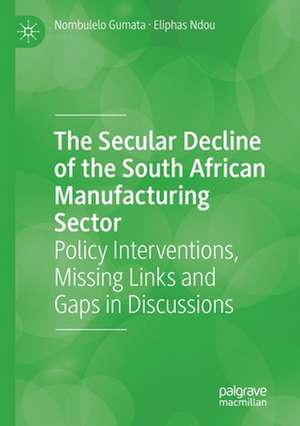The Secular Decline of the South African Manufacturing Sector: Policy Interventions, Missing Links and Gaps in Discussions
Autor Nombulelo Gumata, Eliphas Ndouen Limba Engleză Paperback – 11 noi 2021
| Toate formatele și edițiile | Preț | Express |
|---|---|---|
| Paperback (1) | 644.49 lei 6-8 săpt. | |
| Springer International Publishing – 11 noi 2021 | 644.49 lei 6-8 săpt. | |
| Hardback (1) | 648.24 lei 6-8 săpt. | |
| Springer International Publishing – 11 noi 2020 | 648.24 lei 6-8 săpt. |
Preț: 644.49 lei
Preț vechi: 758.23 lei
-15% Nou
Puncte Express: 967
Preț estimativ în valută:
123.32€ • 129.09$ • 102.64£
123.32€ • 129.09$ • 102.64£
Carte tipărită la comandă
Livrare economică 31 martie-14 aprilie
Preluare comenzi: 021 569.72.76
Specificații
ISBN-13: 9783030551506
ISBN-10: 3030551504
Pagini: 370
Ilustrații: XXXIII, 370 p. 258 illus.
Dimensiuni: 148 x 210 mm
Greutate: 0.53 kg
Ediția:1st ed. 2020
Editura: Springer International Publishing
Colecția Palgrave Macmillan
Locul publicării:Cham, Switzerland
ISBN-10: 3030551504
Pagini: 370
Ilustrații: XXXIII, 370 p. 258 illus.
Dimensiuni: 148 x 210 mm
Greutate: 0.53 kg
Ediția:1st ed. 2020
Editura: Springer International Publishing
Colecția Palgrave Macmillan
Locul publicării:Cham, Switzerland
Cuprins
1. Introduction.- 2. Does trade-openness affect the role of the domestic output-gap on inflation? If so, what is the role of the global out-put gap?.- 3. Does an increase in trade-openness and import-penetration affect income inequality? Evidence from the manufacturing sector output growth and employment growth.- 4. What is the impact of Chinese import penetration on the South African manufacturing sector?.- 5. What is the impact of global trade uncertainty and the exchange rate volatility on the manufacturing sector?.- 6. How does activity in manufacturing sector respond to trade and exchange rate shocks? Evidence from trade-openness and import penetration thresholds.- 7. What is the impact of imports by stage of production on the manufacturing sector output and employment growth?.- 8. What is the impact of imports by stage of production and the manufacturing sector investment growth?.- 9. What is the impact of global trade uncertainty and the exchange rate volatility on the manufacturing sector?.- 10. What is the impact of commodity price booms and capital flows surges episodes on the manufacturing sector?.- 11. What are the effects of capital flow shocks on the domestic manufacturing sector?.- 12. Does the persistent widening in the trade deficit explain the decline in the manufacturing sector output and employment growth?.- 13. Do credit booms, financial and credit cycles affect activity in the manufacturing sector?.- 14. What is the role of business and consumer confidence in amplifying the transmission of positive shocks into the manufacturing sector?.- 15. Do positive investment shocks in the manufacturing sector result in increased labour absorption and participation rates?.- 16. Did the decline in the excess capital adequacy ratio amplify the monetary policy easing and credit cycles on activity in the manufacturing sector?.- 17. Did the increase in excess liquid assets of banks amplify the effects of tight macro-prudential tools on activity in the manufacturing sector?.- 18. Did loose loan-to-value and repayment-to-income ratios amplify commodity price booms on activity in the manufacturing sector?.- 19. Do tight loan-to-value and repayment-to-income ratios in amplify the effects of tight monetary policy cycles on the manufacturing sector activity?.- 20. What is the impact of selected financial regulation and macro-prudential tools on credit to the manufacturing sector?.- 21. Did monetary policy cycles propagate the impact of credit and financial cycles on activity in the manufacturing sector during 2005Q1 and 2008Q3?.- 22. What was the role of demand shocks, supply shocks, productivity shocks and monetary policy shocks on the manufacturing sector during 2005Q1 and 2008Q3?.- 23. The role of electricity price shocks on the manufacturing sector output and employment growth.- 24. What is the impact of the manufacturing sector output and sub-sector employment growth on the labour absorption and participation rates?.- 25. What is the nature of the output-employment in the manufacturing sector? Evidence from the manufacturing subsectors.- 26. What are the effects of the minimum wage and productivity growth on the manufacturing sector output and employment growth?.- 27. What is the impact of market income concentration and the mergers and acquisitions channel on the manufacturing sector?.
Notă biografică
Nombulelo Gumata is an economist who has co-authored several books in the areas of international finance and macroeconomics, macro-prudential and regulatory tools and financial stability, labour markets, monetary and fiscal policy.
Eliphas Ndou is an economist at the South African Reserve Bank and has authored books in international finance, public finances, monetary, labour, macro and microeconomics, time-series econometrics, banking regulation and macro-prudential policy.
Textul de pe ultima copertă
This book examines the global and domestic factors that have influenced the decline of South African manufacturing. Quantitative and econometric techniques are used to analyse the macroeconomic conditions that derive improved performance within the manufacturing sector. Empirical evidence is used to set out policy recommendations that would allow the South African National Development Plan to meet its objectives.
This books aims to bring together analysis of industrial policy, competition policy, and merger remedies to produce a framework on how to preserve a competitive environment and support output, investment, and employment growth. It is relevant to those interested in African, development, and labour economics.
Caracteristici
Highly illustrated with graphs and diagrams that highlight growth indicators and policy implications Contains learning objectives to aid revision and quick reference Examines economic shocks can be managed and their impacts minimised
